| Pages:
1
2 |
MrHomeScientist
International Hazard
    
Posts: 1806
Registered: 24-10-2010
Location: Flerovium
Member Is Offline
Mood: No Mood
|
|
Catalytic Converter PGM Recovery
Because the thread that I posted this comment in was locked (rather inexplicably, which has become a disturbing trend lately), I am reposting my
information and questions here. I was hoping to get some comments on the method, answers to my bolded questions, and when the experiment gets underway
post my results (which people can't do now that the thread is locked, so please do not consider this a double post).
====================================
I might be getting my hands on a catalytic converter, and was going to try my hand at platinum group metal (PGM) recovery. I found a nice "beginner's
guide" that I was going to base my procedure on (attached below). What it boils down to is this:
1) Grind catalytic converter material down to a coarse powder.
2) Incinerate material in a furnace to burn off road dirt and organic residues (if it isn't a brand new converter).
3) Treat material with HCl, followed by HNO3 (separately!). This removes any base metals (this step might be unnecessary).
4) Treat material with aqua regia (3:1 HCl:HNO3) to dissolve platinum and palladium. Rhodium remains insoluble. (how would I separate this
from undissolved ceramic?)
5) Precipitate platinum from solution as the bright yellow ammonium hexachloroplatinate, using a saturated solution of NH4Cl.
6) Precipitate palladium from solution as the bright red ammonium hexachloropalladate, by adding a saturated solution of KClO3 (my source recommends
sodium chlorate, but I have the potassium salt and I can't imagine that would make a difference). Technially, it is the chlorine produced that causes
this compound to form.
7) Calcine both the PGM salts in ceramic dishes to reduce them to their metals - driving off ammonium chloride. Ramp up the heat slowly to avoid
vaporizing any metals. (although, doesn't this step conflict with (2), above? If we want to heat slowly to avoid vaporizing metals now,
wouldn't incinerating the honeycomb earlier be doing some vaporizing?)
Here is another guide that has the same overall process, but differs a bit on terminology. e.g. it calls the brick red precipitate ammonium
hexachloropalladate rather than a chlorate salt like the attachment does. Theirs seems to make more sense, so I went with that name above.
Any comments on this method? Suggestions, things to avoid, etc.? I have no intention of making money off of this, I simply want to explore the process
and get some palladium and rhodium for my element collection!
Attachment: PGM Recovery from Catalytic Converters.pdf (282kB)
This file has been downloaded 19401 times
|
|
|
blogfast25
International Hazard
    
Posts: 10562
Registered: 3-2-2008
Location: Neverland
Member Is Offline
Mood: No Mood
|
|
Nice finds, MrHS. I think you've got everything you need there for a decent first run. Getting hold of an old catalytic converter may not be so easy
though.
BleepingAmazing will probably think all this is not 'alchemical' enough and will want to 'invent' his own process, possibly one that involves getting
splattered with steam/H2SO4. Each to his own, I guess!
[Edited on 22-8-2013 by blogfast25]
|
|
|
froot
Hazard to Others
  
Posts: 347
Registered: 23-10-2003
Location: South Africa
Member Is Offline
Mood: refluxed
|
|
| Quote: | | 4) Treat material with aqua regia (3:1 HCl:HNO3) to dissolve platinum and palladium. Rhodium remains insoluble. (how would I separate this from
undissolved ceramic?) |
I would try NaOH, molten or hot solution.
| Quote: | | 7) Calcine both the PGM salts in ceramic dishes to reduce them to their metals - driving off ammonium chloride. Ramp up the heat slowly to avoid
vaporizing any metals. (although, doesn't this step conflict with (2), above? If we want to heat slowly to avoid vaporizing metals now, wouldn't
incinerating the honeycomb earlier be doing some vaporizing?) |
I would imagine step 2 involves temps up to 500 degC in air while step 7 involves much higher temps. If you have a flame directed at the metal and the
colour of the flame changes, chances are the metal is slowly vaporising via the flame and in this case no flux is used to protect the values. The
slower velocity the flame the better. If it's done in an oven, even better.
Remember that these cat converters have been subjected to hot high velocity exhaust gases for hundreds of hours so I wouldn't stress too much about
loss by vaporisation.
Edit: found some info here: http://metals.about.com/od/properties/a/Metal-Profile-Rhodiu...
| Quote: | The first step in extracting rhodium from the ore, is precipitating precious metals such as gold, silver, palladium and platinum. The remaining ore is
treated with sodium bisulphate NaHSO4 and melted, resulting in rhodium (III) sulfate, Rh2(SO4)3.
Rhodium hydroxide is then precipitated out using sodium hydroxide, while hydrochloric acid is added to produce H3RhCl6. This compound is treated with
ammonium chloride and sodium nitrite to from a precipitate of rhodium.
The precipitate is dissolved in hydrochloric acid and the solution is heated until residual contaminants are burnt off, leaving behind the pure
rhodium metal. |
Maybe you could apply this to your process.
[Edited on 22-8-2013 by froot]
We salute the improvement of the human genome by honoring those who remove themselves from it.
Of necessity, this honor is generally bestowed posthumously. - www.darwinawards.com |
|
|
Fleaker
International Hazard
    
Posts: 1252
Registered: 19-6-2005
Member Is Offline
Mood: nucleophilic
|
|
Gross oversimplification and you're liable to get in trouble with catalyst.
Leaching PGMs out of a honeycomb should be done as a hobbyist endeavor--don't think you can get the recovery or the value to make it compare with arc
melting the catalyst with a collector metal ( BASF is one company doing this, in Seneca, SC).
) Grind catalytic converter material down to a coarse powder.
Not necessary, as most of the PGM is in the wash coat. Increasing surface area of the material by grinding increases solution holdup. The
material should be crushed, ground, and sieved only if it's being prepared for sampling and sending out to the smelter.
2) Incinerate material in a furnace to burn off road dirt and organic residues (if it isn't a brand new converter).
Incineration is always a good step but must be done at the right temperature; otherwise refractory PdO and Rh2O3 form that do not dissolve
well in an aqueous leach.
3) Treat material with HCl, followed by HNO3 (separately!). This removes any base metals (this step might be unnecessary).
It is unnecessary. You will not have enough of a reduction of base metal contamination--all this accomplishes is making a base metal solution
that may have Pd in it (Pd will dissolve in HCl, if the Pd is fine enough and the HCl is concentrated and air is let in).
4) Treat material with aqua regia (3:1 HCl:HNO3) to dissolve platinum and palladium. Rhodium remains insoluble. (how would I separate this from
undissolved ceramic?)
Aqua regia is a bad lixiviant for this material. Better to use 6 M HCl and a chlorine source. Rhodium doesn't remain insoluble. With the right
chlorination conditions, over 90%+ of the Rh goes in with the Pd and Pt.
5) Precipitate platinum from solution as the bright yellow ammonium hexachloroplatinate, using a saturated solution of NH4Cl.
Well, given the solubility curve for ammonium hexachloroplatinate, what will probably happen is nothing. Unless you concentrate your solution
(think about the mass of catalyst to lixiviant ratio), all you are doing is making an ammonium-containing liquor that's expensive to dispose of via
normal waste treatment. Better to use borohydride, or perhaps aluminum powder as the reductant.
6) Precipitate palladium from solution as the bright red ammonium hexachloropalladate, by adding a saturated solution of KClO3 (my source recommends
sodium chlorate, but I have the potassium salt and I can't imagine that would make a difference). Technially, it is the chlorine produced that causes
this compound to form.
Again, forget about this step from dilute solutions. There's really nothing quantitative about PGM separations via classical
hydrometallurgy.
7) Calcine both the PGM salts in ceramic dishes to reduce them to their metals - driving off ammonium chloride. Ramp up the heat slowly to avoid
vaporizing any metals. (although, doesn't this step conflict with (2), above? If we want to heat slowly to avoid vaporizing metals now, wouldn't
incinerating the honeycomb earlier be doing some vaporizing?)
This is what you do AFTER the material is refined. For the purposes of the amateur enthusiast, this shouldn't be done; you can clean up the
Pt/Rhwell enough, and the Pd is easily refined. In grand scale, this is the best way to get PGM sponges.
You don't want to use molten NaOH. Dangerous as all heck, it dissolves the PGMs.
As for the rhodium refining sequence described...it's a lot more involved than that. It's also not practical to use bisulfate unless at the lab scale.
The amounts of SO3 produced are very dangerous.
I think your goal should be making a cemented product of Pd/Pt/Rh. Then you can try separating them.
Separation of Pd/Pt/Rh is not easy but there are numerous ways to do it and avoid using ammonium chloride.
Neither flask nor beaker.
"Kid, you don't even know just what you don't know. "
--The Dark Lord Sauron
|
|
|
MrHomeScientist
International Hazard
    
Posts: 1806
Registered: 24-10-2010
Location: Flerovium
Member Is Offline
Mood: No Mood
|
|
Awesome information, thanks for the posts. That gives me a lot to think about. Fleaker, with your valuable metals experience I was
hoping you'd respond  This is most certainly a hobbiest endeavor, I have no
delusions about making my fortune doing this. I simply wanted to have fun with the process and recover some elements for my collection. This is most certainly a hobbiest endeavor, I have no
delusions about making my fortune doing this. I simply wanted to have fun with the process and recover some elements for my collection.
Some further questions on your comments:
1) Makes sense. The values are all on the surface anyway.
2) What temperature would be too high? I was probably going to put the material in a crucuble in my aluminum-melting furnace (currently charcoal
powered, but I'm working on a propane version). So it wouldn't be directly exposed to flame. It looks like PdO forms at 350 C though, so this might be
excessive heat.
3) Agreed.
4) Why is aqua regia bad in this case? Because it does not dissolve Rh? HCl + Cl2 should be simple enough to implement - I have a gas
washing bottle that I could charge with catalyst, fill with HCl, and bubble chlorine in from the bottom (although I've never been able to use this
without causing suckback!).
5) & 6) I had planned on concentrating the solutions, based on my other reading, but had neglected to include that step here.
7) I didn't really understand your points here. Since this was how I was planning on getting my metal powders, how would further heating after this
final refining step help?
Cementing out all the PGMs at once would certainly be simpler, but I wanted to separate them as much as possible. Wouldn't separating a mix of metal
powders just be the process I outlined above? That's what the honeycomb is coated with in the first place, after all. I can't think of any
physical methods of separation, but then again I hadn't researched that avenue. Why should ammonium chloride be avoided?
[Edited on 8-22-2013 by MrHomeScientist]
|
|
|
Fleaker
International Hazard
    
Posts: 1252
Registered: 19-6-2005
Member Is Offline
Mood: nucleophilic
|
|
You're thinking right. PdO is what you do not want to form. Now comes the issue of "but how do I de-coke/carburise the catalyst at a measly 350*C?".
Good point. Heat it too hot and you have PdO that's not well soluble in acids. Heat it not enough, you have fine carbon black soot that holds value by
adsorption. What to do? Bear in mind that most petrol engines are tuned to run rich so that the Pd isn't really oxidized in the converter itself.
Aqua regia is bad because it's bad. The only time aqua regia is indicated for precious metals refining is when you have bulk pieces of platinum,
palladium or gold--then you can get a better dissolution time. For fine powders, HCl/Cl2 system is great. Bromine-HBr systems work well too (because
you can reflux the bromine and then then sparge with chlorine to rid the system of bromine for re-use).
Also, excess nitric acid means much of your platinum will be dissolved as its nitrosyl complex. This makes cementation exponentially more difficult
(can you imagine all the NOx?). It's also expensive, hazardous, and completely unnecessary. Aqua regia does indeed dissolve rhodium, just not very
fast. But not much does dissolve rhodium (or iridium) very expediently.
Don't bother bubbling the chlorine unless you really are an ardent admirer of Len1's prepub work--just generate it in situ with hydrogen peroxide. You
won't need much and you can conduct this at room temp.
Ammonium chloride should be avoided because of this situation:
1. Waste treatment. Makes ammonia which chelates any other free metals. We've eliminated it as much as possible.
2. Practicality: in working with PGMs, generally, you want the solution as concentrated as possible if using conventional hydrometallurgy. Figure it
takes two liters of HCl-Cl2 mix to do a converter. You now have, at best, a 2 g/L Pt solution, 1-1.5 g/L Pd, and perhaps 0.5 g/L Rh. Add ammonium
chloride and see what happens. Probably not much of anything! You'd have to concentrate down a lot of solution.
Best to work on the small scale, dissolve all the cemented powders up, and then go about it classically. You do know how to do that, don't you? Brauer
is a good start and you can always hit the goldrefiningforum if you need a picture tutorial.
Neither flask nor beaker.
"Kid, you don't even know just what you don't know. "
--The Dark Lord Sauron
|
|
|
bfesser
Resident Wikipedian
    
Posts: 2114
Registered: 29-1-2008
Member Is Offline
Mood: No Mood
|
|
I just want to say that I'm glad to see discussion on this topic has resumed, and in a reasonable and intelligent manner. I really disliked having to
close the other thread.
|
|
|
blogfast25
International Hazard
    
Posts: 10562
Registered: 3-2-2008
Location: Neverland
Member Is Offline
Mood: No Mood
|
|
Fleaker:
You are w/o a shadow of a doubt the resident expert on PGM recovery. Here's a simple question: can amateur recover of PGMs from a single catconverter
even be done in a break-even way? Taking into account not labour but all chemical/energy costs? Or should it be seen as a chemical adventure with
possibly a very small mixed PGM nugget at the end of the rainbow?
|
|
|
MrHomeScientist
International Hazard
    
Posts: 1806
Registered: 24-10-2010
Location: Flerovium
Member Is Offline
Mood: No Mood
|
|
After Fleaker's advice on using the HCl/H2O2 system, I did some more searching and found this paper:
Attachment: PGM Recovery Rumpold.pdf (960kB)
This file has been downloaded 939 times
It's a very interesting read. In it, they lay out the equations for PGM dissolution:
Pt(s) + 8H+ + 4O- + 6Cl- → [PtCl6]2- + 4H2O(l)
Pd(s) + 4H+ + 2O- + 4Cl- → [PdCl4]2- + 2H2O(l)
2Rh(s) + 12H+ + 6O- + 12Cl- → 2[RhCl6]3- + 6H2O(l)
At another site, I also found reactions pertaining to the acid/peroxide system:
H2O2 + 2H+ + 2Cl- → Cl2 + 2H2O
H2O2 + Cl2 → O2 + 2H+ + 2Cl-
(phew, that was a lot of HTML tags  ) )
They also talk about cerium recovery, which is something I hadn't seen before and I'll have to try as well since I don't have that one in the
collection either. They add sulfuric acid to their solution of hydrochloric/peroxide "to compensate for the hydrogen consumption." They then state:
| Quote: | | The experiments were carried out with 150 g of catalyst and 570 ml of synthetic solution. To enhance the leaching conditions, the temperature was
raised to 80°C. The addition of the hydrogen peroxide was made very slowly to avoid extreme bubble formation. |
They do not define "synthetic solution," but I presume this to be the hydrochloric/sulfuric acid mix, to which they slowly add peroxide. They do not
state any amounts or concentrations besides these numbers, so I'm not sure where to go as far as practial application (what % peroxide? how much to
add? etc.). I should be able to use the above equations as a starting point, although I've never seen the use of an oxygen ion before (I assume this
comes from the peroxide).
This seems very difficult to know how much to use for all the reagents regardless, because the peroxide is decomposed by the chloride ions, road grime
side reactions, unknown amount of PGM material, etc. Is there any clear indication, like "solution becomes colorless", "bubbling stops", etc.?
Fleaker, no I have to admit I don't really know the "classical" method. I've never done these sorts of reactions before. I will
consult Brauer and the gold refining forum as you suggested; I've ran across the latter a few times in my research already. This is all very exciting!
There's some very rich chemistry here (pun intended)!
|
|
|
blogfast25
International Hazard
    
Posts: 10562
Registered: 3-2-2008
Location: Neverland
Member Is Offline
Mood: No Mood
|
|
Mr HS:
The first three equations don't make any sense at all: 4 H+ + 2 O2- for instance really means 2
H2O! "O2-" can't exist in aqueous solution anyway: as an "acid" water is far too weak for a second deprotonation step.
More importantly, the equations don't account for the oxidations of the metals AT ALL!
But the file is interesting in many other respects.
Re. Ce, CeO2, even reagent grade, is not expensive. But turning it into metal is quite another thing. Assuming the lixiviate contains
CeCl3 (Ce IV oxidises Cl- to Cl2), precipitation as the double salt with K2SO4 should be near
quantitative by saturating the solution with that salt, after removal of the PGMs.
Edit:
The first equation, assuming chlorine was the oxidiser in acid (HCl) conditions, would simply be:
Pt (s) + 2 Cl2 (aq) + 2 HCl (aq) === > H2PtCl6 (aq)
... although it would mainly serve stoichiometrical purposes.
[Edited on 24-8-2013 by blogfast25]
|
|
|
bfesser
|
Threads Merged
4-9-2013 at 14:47 |
bfesser
|
Thread Split
5-9-2013 at 17:05 |
MrHomeScientist
International Hazard
    
Posts: 1806
Registered: 24-10-2010
Location: Flerovium
Member Is Offline
Mood: No Mood
|
|
Update
I have my donated catalytic converter now, and even found someone to slice it open for me!
Looks like it was from a VW, with what I assume is a part number stamped on it. It doesn't look all that dirty inside either, which is nice. Once I
get some time (so many things vying for my attention now), I'll proceed with experimenting! I want to try both aqua regia and HCl/Cl2 on
small samples and see how each goes.
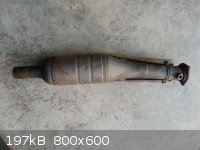 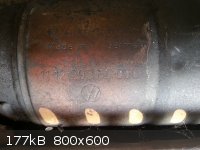 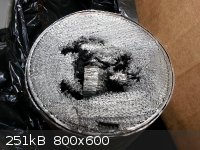
|
|
|
Magpie
lab constructor
    
Posts: 5939
Registered: 1-11-2003
Location: USA
Member Is Offline
Mood: Chemistry: the subtle science.
|
|
At some point I would like to experiment with catalytic hydrogenations. I know that some of this can be done with Pd/C powders, like hydrogenation of
unsaturated fatty acids. Would the catalyst from auto exhaust catalytic converters (CC's) be suitable for this and/or other hydrogenations?
Also I heard from one auto mechanic (possibly a crank) who said that the recycling of used CC's is tightly controlled by the government with heavy
fines for diversion out of the recycling system. Is this true?
The single most important condition for a successful synthesis is good mixing - Nicodem
|
|
|
elementcollector1
International Hazard
    
Posts: 2684
Registered: 28-12-2011
Location: The Known Universe
Member Is Offline
Mood: Molten
|
|
Quote: Originally posted by Magpie  | | Also I heard from one auto mechanic (possibly a crank) who said that the recycling of used CC's is tightly controlled by the government with heavy
fines for diversion out of the recycling system. Is this true? |
Probably the same people who regulate melting the zinc out of a penny.
Elements Collected:52/87
Latest Acquired: Cl
Next in Line: Nd
|
|
|
violet sin
International Hazard
    
Posts: 1475
Registered: 2-9-2012
Location: Daydreaming of uraninite...
Member Is Offline
Mood: Good
|
|
with regards to the recycling of cats thing. (purely speculation) but the insurance company may want a FULL return on a wrecked car. meaning
diversion for other uses amounts to theft in their eyes. but I do know for certain ( mechanics I have asked ) that some people try to buy a used one
to put BACK on their car at a lower cost. guy told me I can't buy one from some one and have it put on my car, it has to be new. I just wanted to
know about getting some material for this process and he looked at me like I was a few min away from doing some crystal meth and coming back with a
freshly hacksawed CAT for him weld to my car( which didn't need a new one). so I did a little reading and it seems mainly environmental protection
laws about certified used and aftermarket replacements.
http://davisconverters.com/statelaws/California-State-Laws.s...
"Beginning July 10, 2008, no used converter can be legally advertised for sale, sold as replacement, or installed in California after this date."
http://www.dec.ny.gov/chemical/87411.html
"A used catalytic converter is not a new aftermarket catalytic converter, or a replacement part as defined below. This prohibition does not apply to
the sale of used catalytic converters for recycling purposes."
the last reference makes it pretty clear(in new york), for cash = no prob, for USE = illegal.
-Violet Sin-
|
|
|
Magpie
lab constructor
    
Posts: 5939
Registered: 1-11-2003
Location: USA
Member Is Offline
Mood: Chemistry: the subtle science.
|
|
I have not done any research on this myself but what you are saying Violet Sin makes sense, ie, that there are laws against reuse of a used CC on an
automobile. Another mechanic was showing me a barrel of used auto parts he was going to sell as scrap metal. Sitting in this barrel (outside the
shop) was a used CC.
The single most important condition for a successful synthesis is good mixing - Nicodem
|
|
|
Traveller
Hazard to Self
 
Posts: 98
Registered: 29-9-2012
Location: western Canada
Member Is Offline
Mood: inquisitive
|
|
It was a more lucrative business when Rhodium was up at $10,000 per Troy ounce. The crash in 2008 knocked the price way down and it has never
recovered. It got back up to $3000/oz. in 2010 for a while but for a long time now it has been on a steady decline from there and is now close to
$1000/oz. Rumour has it that new technology in CC's has cut down drastically the requirement for Rhodium, while requiring more Palladium.
|
|
|
MrHomeScientist
International Hazard
    
Posts: 1806
Registered: 24-10-2010
Location: Flerovium
Member Is Offline
Mood: No Mood
|
|
Update 2
To do some initial testing, I broke off a few small pieces of the converter material, totaling 1.9g, and placed these in a test tube. I added 20mL of
9.5M hydrochloric acid, and it actually started reacting with the honeycomb material! It formed lots of bubbles and turned the solution almost
completely black. From smell it seemed like the gas was chlorine, but I could have mixed that up with HCl vapors and I didn't try any definitive
testing to determine its identity. After leaving it to react for two days, I added a roughly equal amount of water to dilute it and discovered the
solution was actually a deep green.
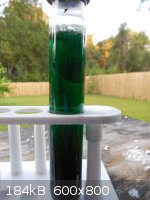
Surprising, since I thought the honeycomb would be unreactive ceramic. Could the color come from nickel, perhaps?
I suppose the next step would be to filter off the solids and treat these with nitric acid to see if there is any reaction there. Then, aqua regia to
get the PGMs in solution. I know aqua regia was frowned upon earlier in the thread, but I wanted to do some small scale testing to see if I could
recover anything at all.
|
|
|
elementcollector1
International Hazard
    
Posts: 2684
Registered: 28-12-2011
Location: The Known Universe
Member Is Offline
Mood: Molten
|
|
Quote: Originally posted by MrHomeScientist  | To do some initial testing, I broke off a few small pieces of the converter material, totaling 1.9g, and placed these in a test tube. I added 20mL of
9.5M hydrochloric acid, and it actually started reacting with the honeycomb material! It formed lots of bubbles and turned the solution almost
completely black. From smell it seemed like the gas was chlorine, but I could have mixed that up with HCl vapors and I didn't try any definitive
testing to determine its identity. After leaving it to react for two days, I added a roughly equal amount of water to dilute it and discovered the
solution was actually a deep green.
Surprising, since I thought the honeycomb would be unreactive ceramic. Could the color come from nickel, perhaps?
I suppose the next step would be to filter off the solids and treat these with nitric acid to see if there is any reaction there. Then, aqua regia to
get the PGMs in solution. I know aqua regia was frowned upon earlier in the thread, but I wanted to do some small scale testing to see if I could
recover anything at all. |
That green actually reminds me of Cr(III) - see if you can add some NaOH and NaOCl and get a yellow solution.
Elements Collected:52/87
Latest Acquired: Cl
Next in Line: Nd
|
|
|
plante1999
International Hazard
    
Posts: 1936
Registered: 27-12-2010
Member Is Offline
Mood: Mad as a hatter
|
|
I don't find it really surprizing as your honeycombs doesn't look like the ceramic one. They look more like the metal varient, which I forgot the
composition.
I never asked for this.
|
|
|
blogfast25
International Hazard
    
Posts: 10562
Registered: 3-2-2008
Location: Neverland
Member Is Offline
Mood: No Mood
|
|
It could also be plain Fe2+. With NaOH and NaOCl that would give red/brownish Fe(OH)3 precipitation.
If no precipitate forms and you get a yellow solution, add some lead nitrate (or acetate), to form definitive PbCrO4, a yellow precipitate that's hard
to mistake for anything else (in this context).
Quote: Originally posted by plante1999  | | I don't find it really surprizing as your honeycombs doesn't look like the ceramic one. They look more like the metal varient, which I forgot the
composition. |
Revisiting that photo, that cross section looks very metallic, indeed. If so, you'll need a ton of acid to dissolve that away!
[Edited on 14-10-2013 by blogfast25]
|
|
|
bismuthate
National Hazard
   
Posts: 803
Registered: 28-9-2013
Location: the island of stability
Member Is Offline
Mood: self reacting
|
|
that looks to me like a concentrated CuCl solution , but HCl will only attack copper in the presence of an oxidiser so that should be impossible. Add
a solution of baking soda and you should be able to identify the percipitate by color.
|
|
|
MrHomeScientist
International Hazard
    
Posts: 1806
Registered: 24-10-2010
Location: Flerovium
Member Is Offline
Mood: No Mood
|
|
Wow lots of ideas! And all of them doable with my current stock of chemicals. I'll try and do some testing at some point this week.
|
|
|
Oscilllator
National Hazard
   
Posts: 659
Registered: 8-10-2012
Location: The aqueous layer
Member Is Offline
Mood: No Mood
|
|
I seriously doubt that the green colour is nickel. I have previously tried to dissolve nickel in concentrated hydrochloric acid, and the reaction
proceeds at an extremely slow rate unless an oxidiser (I used H2O2) is present. Also, the deep green colour of the solution would mean the nickel
would have to be fairly concentrated, and since you only put 1.9g in this test tube, this seems highly unlikely.
|
|
|
froot
Hazard to Others
  
Posts: 347
Registered: 23-10-2003
Location: South Africa
Member Is Offline
Mood: refluxed
|
|
Did you check the material's magnetic properties?
We salute the improvement of the human genome by honoring those who remove themselves from it.
Of necessity, this honor is generally bestowed posthumously. - www.darwinawards.com |
|
|
MrHomeScientist
International Hazard
    
Posts: 1806
Registered: 24-10-2010
Location: Flerovium
Member Is Offline
Mood: No Mood
|
|
I did some testing with the green solution.
I took 1mL and placed this in a test tube, then diluted with 1mL of water. In another test tube I prepared a solution of several mL of bleach and
about 1g NaOH (I didn't make precise measurements).
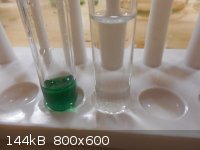
Combining the two yielded no change for the first few mL (as the solution was neutralized), but then sudden precipitation of a brown goo that I've
seen many times before - iron hydroxide. This settled after several minutes, leaving a light brown solution.
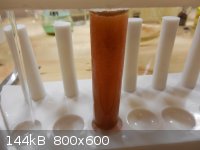 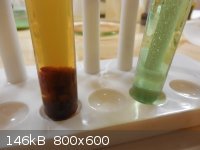
I also tried out adding hydrogen peroxide (3%) to another milliliter of converter solution to try that route to convert it to brown iron(III). There
was lots of bubbling, but no change in color beyond lightening from the dilution. That tube is on the right in the picture of the settled precipitate.
Also, the raw converter material is indeed magnetic, as you'd expect from the results pointing to iron above.
Finally, I tried adding a solution of a tiny amount of lead nitrate to a sample of the brown solution from picture 3 above. No change at first, but
after about 5 minutes I did see a small amount of a precipitate.
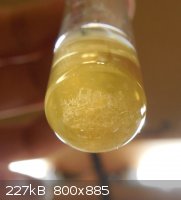
So this seems to confirm that my metallic-looking converter substrate is iron with at least a chromium impurity.
|
|
|
| Pages:
1
2 |